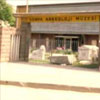
In Ereğli Museum, which has been established in 1968, 8096 cultural assets are exhibited. Annual average visitor number is 10900. The museum has a large open exhibition, but closed exhibition is made in a hall.
Ereğli Museum is the synthesis of all civilizations starting from 7000 BC since Neolithic Period without interruption. Herakleia archaic city and the cultural assets found around are exhibited in Ereğli Museum. The hand axes found in Can Hasan belonging to the Neolithic Period, wall frescos, hand mills, digging tools and cooked earthenware pots, polichrome cooked earthenware pots belonging to the Calcolithic Period, animal and human figures belonging to the Old Bronze Age, arrow ends, stamp seals, hand axes, water jugs with bulle belonging to Asyrrian Commercial Colony Period, idols, cooked earthenware fruit plates, cooked earthenware salt cups, cylindrical and stamp seals belonging to the Hittite Period, carabeuses, hieroglyph and nail written sculpture bases, fibulas belonging to the Phrygian Era, beak mouthed water jugs, phiales, lekythos belonging to the Hellenistic Period, silver Athena coins called as Herakleia treasure, golden frames, architectural parts belonging to the Roman Period, grave steles, human and animal figures, architectural parts belonging to the Byzantine Period, golden christograms, glazed pots belonging to Seljuk and Karamanoğlu Periods, plaster ornaments, trousseau chest belonging to the Ottoman Period made of rye stem, hand - written Korans with golden prayer beads, guns, hand - woven carpets and kilims are the most important movable cultural assets present in our museum.
Furthermore, İvriz Rock Monument is belonging to the late Hittite Period, golden coated wooden sarcophagus parts belonging to Hellenistic Period, which are found in Göztepe Tumulus and golden Ephesus coin, are among the rarest works in the world.
 In Ereğli Museum, which has been established in 1968, 8096 cultural assets are exhibited. Annual average visitor number is 10900. The museum has a large open exhibition, but closed exhibition is made in a hall.
In Ereğli Museum, which has been established in 1968, 8096 cultural assets are exhibited. Annual average visitor number is 10900. The museum has a large open exhibition, but closed exhibition is made in a hall.